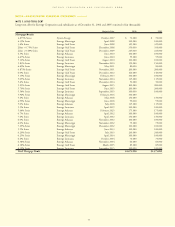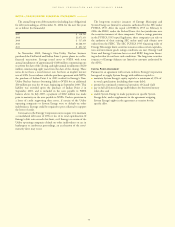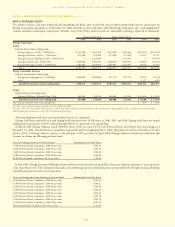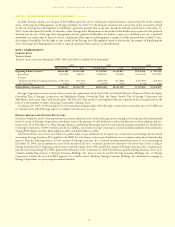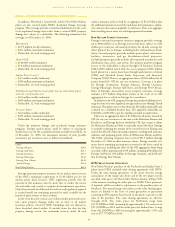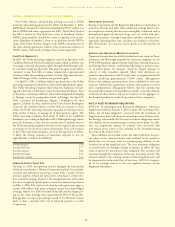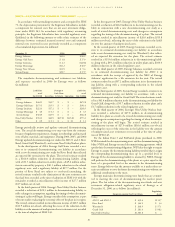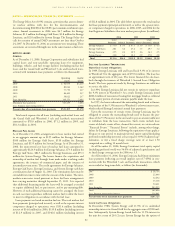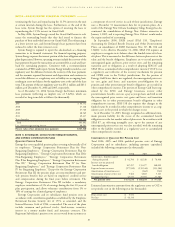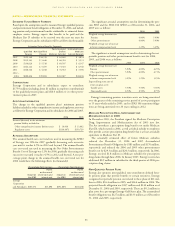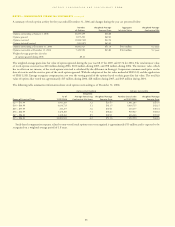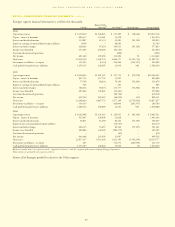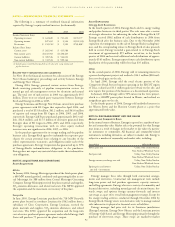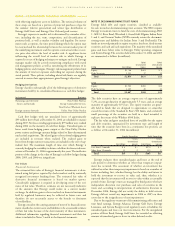Entergy 2006 Annual Report Download - page 99
Download and view the complete annual report
Please find page 99 of the 2006 Entergy annual report below. You can navigate through the pages in the report by either clicking on the pages listed below, or by using the keyword search tool below to find specific information within the annual report.
ENTERGY CORPORATION AND SUBSIDIARIES 2
2000066
terminating the lease and repurchasing the 11.5% interest in the unit
at certain intervals during the lease. Furthermore, at the end of the
lease term, System Energy has the option of renewing the lease or
repurchasing the 11.5% interest in Grand Gulf.
In May 2004, System Energy caused the Grand Gulf lessors to refi-
nance the outstanding bonds that they had issued to finance the
purchase of their undivided interest in Grand Gulf. The refinancing is
at a lower interest rate, and System Energy’s lease payments have been
reduced to reflect the lower interest costs.
System Energy is required to report the sale-leaseback as a financing
transaction in its financial statements. For financial reporting purposes,
System Energy expenses the interest portion of the lease obligation and the
plant depreciation. However, operating revenues include the recovery of the
lease payments because the transactions are accounted for as a sale and lease-
back for ratemaking purposes. Consistent with a recommendation
contained in a FERC audit report, System Energy initially recorded as a net
regulatory asset the difference between the recovery of the lease payments
and the amounts expensed for interest and depreciation and continues to
record this difference as a regulatory asset or liability on an ongoing basis,
resulting in a zero net balance for the regulatory asset at the end of the lease
term. The amount of this net regulatory asset was $51.1 million and $63.1
million as of December 31, 2006 and 2005, respectively.
As of December 31, 2006 System Energy had future minimum
lease payments (reflecting an implicit rate of 5.62%), which are
recorded as long-term debt as follows (in thousands):
2007 $ 46,552
2008 47,128
2009 47,760
2010 48,569
2011 49,437
Years thereafter 204,396
Total 443,842
Less: Amount representing interest 98,502
Present value of net minimum lease payments $345,340
NOTE 11. RETIREMENT, OTHER POSTRETIREMENT BENEFITS,
AND DEFINED CONTRIBUTION PLANS
QUALIFIED PENSION PLANS
Entergy has seven qualified pension plans covering substantially all of
its employees: “Entergy Corporation Retirement Plan for Non-
Bargaining Employees,” “Entergy Corporation Retirement Plan for
Bargaining Employees,” “Entergy Corporation Retirement Plan II for
Non-Bargaining Employees,” “Entergy Corporation Retirement
Plan II for Bargaining Employees,” “Entergy Corporation Retirement
Plan III,” “Entergy Corporation Retirement Plan IV for Non-
Bargaining Employees,” and “Entergy Corporation Retirement Plan
IV for Bargaining Employees.” Except for the Entergy Corporation
Retirement Plan III, the pension plans are noncontributory and pro-
vide pension benefits that are based on employees’ credited service
and compensation during the final years before retirement. The
Entergy Corporation Retirement Plan III includes a mandatory
employee contribution of 3% of earnings during the first 10 years of
plan participation, and allows voluntary contributions from 1% to
10% of earnings for a limited group of employees.
Entergy Corporation and its subsidiaries fund pension costs in
accordance with contribution guidelines established by the Employee
Retirement Income Security Act of 1974, as amended, and the
Internal Revenue Code of 1986, as amended. The assets of the plans
include common and preferred stocks, fixed-income securities,
interest in a money market fund, and insurance contracts. The
Registrant Subsidiaries’ pension costs are recovered from customers as
a component of cost of service in each of their jurisdictions. Entergy
uses a December 31 measurement date for its pension plans. As a
result of the Entergy New Orleans bankruptcy filing, Entergy has dis-
continued the consolidation of Entergy New Orleans retroactive to
January 1, 2005, and is reporting Entergy New Orleans’ results under
the equity method of accounting.
In September 2006, FASB issued SFAS 158, “Employer’s
Accounting for Defined Benefit Pension and Other Postretirement
Plans, an amendment of FASB Statements Nos. 87, 88, 106 and
132(R),” to be effective December 31, 2006. SFAS 158 requires an
employer to recognize in its balance sheet the funded status of its ben-
efit plans. This is measured as the difference between plan assets at fair
value and the benefit obligation. Employers are to record previously
unrecognized gains and losses, prior service costs, and the remaining
transition asset or obligation as a result of adopting SFAS 87 and
SFAS 106 as accumulated other comprehensive income (“OCI”) or as
a regulatory asset reflective of the recovery mechanism for pension
and OPEB costs in the Utility’s jurisdictions. For the portion of
Entergy Gulf States that is not regulated, the unrecognized prior serv-
ice cost, gains and losses, and transition asset/obligation for its
pension and other postretirement benefit obligations are recorded in
other comprehensive income. The portion of Entergy Gulf States reg-
ulated by the LPSC and Entergy Louisiana recover other
postretirement benefits costs on a pay as you go basis and will record
the unrecognized prior service cost, gains and losses, and transition
obligation for its other postretirement benefit obligation in other
comprehensive income. SFAS 158 also requires that changes in the
funded status be recorded in other comprehensive income or as a reg-
ulatory asset in the period in which the changes occur.
As of December 31, 2005, Entergy recognized an additional mini-
mum pension liability for the excess of the accumulated benefit
obligation over the fair market value of plan assets. In accordance with
SFAS 87, an offsetting intangible asset, up to the amount of any
unrecognized prior service cost, was also recorded, with the remaining
offset to the liability recorded as a regulatory asset or accumulated
other comprehensive income.
COMPONENTS OF QUALIFIED NET PENSION COST
Total 2006, 2005, and 2004 qualified pension costs of Entergy
Corporation and its subsidiaries, including amounts capitalized,
included the following components (in thousands):
2006 2005 2004
Service cost – benefits earned
during the period $ 92,706 $ 82,520 $ 76,946
Interest cost on projected
benefit obligation 167,257 155,477 148,092
Expected return on assets (177,930) (159,544) (153,584)
Amortization of transition asset – (662) (763)
Amortization of prior service cost 5,462 4,863 5,143
Recognized net loss 43,721 35,604 21,687
Net pension costs $ 131,216 $ 118,258 $ 97,521
Estimated amortization amounts from the regulatory assets or OCI to
net periodic cost in the following year (in thousands):
Prior service cost $ 5,531
Net loss $ 44,316
NOTESto CONSOLIDATED FINANCIAL STATEMENTS continued
83


